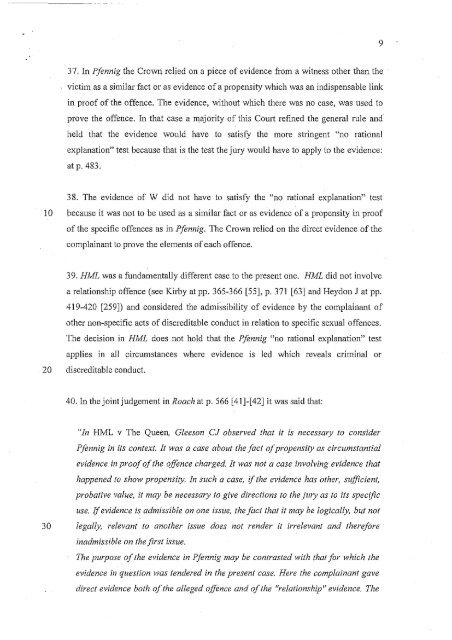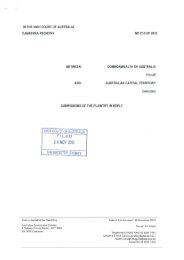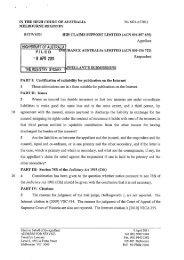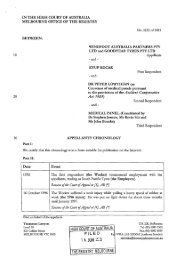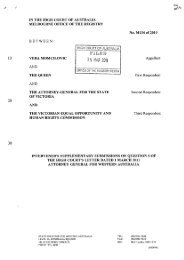Written submissions - High Court of Australia
Written submissions - High Court of Australia
Written submissions - High Court of Australia
Create successful ePaper yourself
Turn your PDF publications into a flip-book with our unique Google optimized e-Paper software.
9<br />
37. In Pfennig the Crown relied on a piece <strong>of</strong> evidence from a witness other than the<br />
victim as a similar fact or as evidence <strong>of</strong> a propensity which was an indispensable link<br />
in pro<strong>of</strong> <strong>of</strong> the <strong>of</strong>fence. The evidence, without which there was no case, was used to<br />
prove the <strong>of</strong>fence. In that case a majority <strong>of</strong> this <strong>Court</strong> refined the general rule and<br />
held that the evidence would have to satisfy the more stringent "no rational<br />
explanation" test because that is the test the jury would have to apply to the evidence:<br />
at p. 483.<br />
38. The evidence <strong>of</strong> W did not have to satisfy the "no rational explanation" test<br />
10 because it was not to be used as a similar fact or as evidence <strong>of</strong> a propensity in pro<strong>of</strong><br />
<strong>of</strong> the specific <strong>of</strong>fences as in Pfennig. The Crown relied on the direct evidence <strong>of</strong> the<br />
complainant to prove the elements <strong>of</strong> each <strong>of</strong>fence.<br />
39. HML was a fundamentally different case to the present one. HML did not involve<br />
a relationship <strong>of</strong>fence (see Kirby at pp. 365-366 [55], p. 371 [63] and Heydon J at pp.<br />
419-420 [259]) and considered the admissibility <strong>of</strong> evidence by the complainant <strong>of</strong><br />
other non-specific acts <strong>of</strong> discreditable conduct in relation to specific sexual <strong>of</strong>fences.<br />
The decision in HML does not hold that the Pfennig "no rational explanation" test<br />
applies in all circumstances where evidence is led which reveals criminal or<br />
20 discreditable conduct.<br />
40. In the joint jUdgement in Roach at p. 566 [41]-[42] it was said that:<br />
"In HML v The Queen, Gleeson CJ observed that it is necessary to consider<br />
Pfennig in its context. It was a case about the fact <strong>of</strong> propensity as circumstantial<br />
evidence in pro<strong>of</strong> <strong>of</strong> the <strong>of</strong>fence charged It was not a case involving evidence that<br />
happened to show propensity. In such a case, if the evidence has other, sufficient,<br />
probative value, it may be necessary to give directions to the jury as to its specific<br />
use. If evidence is admissible on one issue, the fact that it may be logically, but not<br />
30 legally, relevant to another issue does not render it irrelevant and therefore<br />
inadmissible on the first issue.<br />
The purpose <strong>of</strong> the evidence in Pfennig may be contrasted with that for which the<br />
evidence in question was tendered in the present case. Here the complainant gave<br />
direct evidence both <strong>of</strong> the alleged <strong>of</strong>fence and <strong>of</strong> the "relationship" evidence. The


